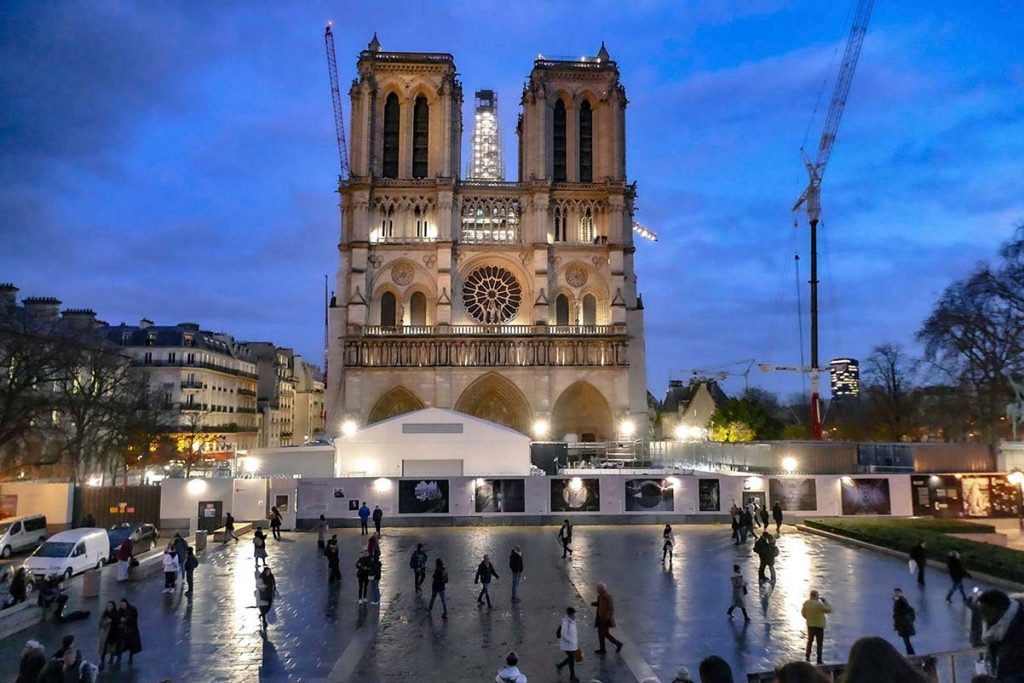Paris, the City of Light, beckons with its rich history and iconic landmarks. My recent journey to this historic city was a captivating exploration of timeless monuments that have witnessed centuries unfold. I recount my experiences at three personally visited landmarks and share recommendations for four must-visit sites, delving into the intricacies of each, from services and advantages to drawbacks and personal insights.
Explored Landmarks:
The Louvre Museum:
Description:
The Louvre, a colossal repository of art and history, unfolded before me like a grand narrative etched in stone. The glass pyramid, an iconic entrance, led me to a labyrinth of galleries housing an unparalleled collection. From the enigmatic smile of the Mona Lisa to the imposing beauty of the Winged Victory of Samothrace, each exhibit was a brushstroke in the vast canvas of human creativity.
Services & Advantages:
The Louvre offered comprehensive guided tours in multiple languages, providing historical context and artistic insights. The museum’s audio guide was a valuable companion, enhancing my understanding of the artworks. The advantage of a vast collection allowed flexibility in exploration, catering to diverse artistic tastes.
Drawbacks:
However, the sheer size of the Louvre could be overwhelming for some, leading to potential exhaustion. The crowd during peak hours also posed a challenge for those seeking a more intimate experience.
Geographical Location:
The Louvre is situated on the Right Bank of the Seine River, in the 1st arrondissement. How to Reach:
Accessible by Metro (Palais Royal – Musée du Louvre station) and bus, the Louvre is centrally located, facilitating easy navigation.
Route Recommendation:
Combining a visit to the Louvre with a stroll along the nearby Tuileries Garden offers a balanced exploration of art and nature.
Ticket Prices & Discounts:
Admission fees vary, with discounts for students and seniors. Online ticket purchase is recommended for time efficiency.
Recommendation Index:
The Louvre earns a high recommendation for art enthusiasts and history buffs, offering an immersive journey through diverse periods and cultures.
Booking Platform & Experience:
Booking through the official Louvre website was seamless, providing detailed information and facilitating a smooth entry process. The online platform also allowed me to customize my visit, selecting specific exhibits of interest.
Notre-Dame Cathedral:
Description:
Standing as a testament to Gothic architecture, Notre-Dame Cathedral emanated a timeless aura. Despite the tragic fire in 2019, the cathedral’s resilience and ongoing restoration efforts echoed a narrative of hope. The intricate facade, adorned with gargoyles and statues, narrated tales of a bygone era, inviting me to step into history. Services & Advantages:
The guided tours provided by knowledgeable docents illuminated the historical and architectural significance of Notre-Dame. Access to the towers allowed for a panoramic view of Paris, making the climb worthwhile.
Drawbacks:
The ongoing restoration limited access to certain areas, affecting the comprehensiveness of the visit. Additionally, long queues were common during peak hours.
Geographical Location:
Notre-Dame is located on the Île de la Cité, surrounded by the Seine River. How to Reach:
Accessible by Metro (Cité or Saint-Michel stations) and various buses, Notre-Dame’s central location eases transportation.

Route Recommendation:
Pairing a visit to Notre-Dame with a stroll along the picturesque Île Saint-Louis provides a serene contrast to the grandeur of the cathedral.
Ticket Prices & Discounts:
Admission fees contribute to the restoration fund. Discounts are available for students and children. Online reservations help avoid long queues.
Recommendation Index:
Notre-Dame Cathedral earns a strong recommendation for those fascinated by Gothic architecture and the resilience of cultural landmarks.
Booking Platform & Experience:
Online booking through the official Notre-Dame website facilitated a smoother entry process, providing essential information about the ongoing restoration efforts and the significance of visitor contributions.
Versailles Palace:
Description:
The opulence of Versailles Palace transported me to the splendor of the French monarchy. The Hall of Mirrors, with its breathtaking reflections and ornate decor, epitomized the grandeur of Louis XIV’s reign. The vast gardens, adorned with sculptures and fountains, offered a tranquil escape into nature’s embrace.
Services & Advantages:
Versailles Palace provided guided tours in multiple languages, unraveling the history behind each room and hall. The expansive gardens allowed for leisurely strolls, with golf cart rentals available for those seeking a more relaxed exploration.
Drawbacks:
The popularity of Versailles resulted in large crowds, particularly in the summer months, impacting the intimacy of the visit. Navigating the extensive gardens could be time-consuming. Geographical Location:
Versailles is located approximately 20 kilometers southwest of Paris.
How to Reach:
Accessible by train (RER C line) or a guided bus tour, Versailles is a day-trip destination reachable within an hour from central Paris.
Route Recommendation:
Pairing a visit to Versailles with a picnic in the gardens provides a balanced experience of both regal opulence and natural serenity.
Ticket Prices & Discounts:
Admission fees vary, with separate charges for the palace and gardens. Discounts are available for students and children. Online reservations help avoid long lines.
Recommendation Index:
Versailles Palace is highly recommended for history enthusiasts and admirers of baroque architecture, offering a glimpse into the extravagant lifestyle of French royalty.
Booking Platform & Experience:
Booking through the official Château de Versailles website allowed for a hassle-free experience, with the option to customize the visit based on personal interests. The platform also provided insights into special exhibitions and events.
Recommended Landmarks:
Sainte-Chapelle:
Description:
Sainte-Chapelle, nestled within the medieval Palais de la Cité, is a gem of Gothic architecture. The stained glass windows, depicting biblical narratives, create an ethereal atmosphere, bathing the interior in a kaleidoscope of colors.
Services & Advantages:
Despite its relatively compact size, Sainte-Chapelle offers guided tours that unravel the historical and artistic significance of its architecture and stained glass. The intimate setting provides a more immersive experience compared to larger cathedrals.
Drawbacks:
Limited space may result in crowds during peak hours, affecting the tranquility of the visit.
Geographical Location:
Sainte-Chapelle is located on the Île de la Cité, adjacent to Notre-Dame Cathedral. How to Reach:
Accessible by Metro (Cité or Saint-Michel stations) and various buses, Sainte-Chapelle is conveniently situated for a combined visit with Notre-Dame.
Route Recommendation:
Exploring Sainte-Chapelle and Notre-Dame on the same day allows for a seamless exploration of Gothic architectural wonders.

Ticket Prices & Discounts:
Admission fees are reasonable, with discounts for students and children. Online reservations are recommended.
Recommendation Index:
Sainte-Chapelle earns a strong recommendation for those seeking an intimate encounter with Gothic architecture and breathtaking stained glass artistry.
Booking Platform & Experience:
Online booking through the official Sainte-Chapelle website ensures a smoother entry process, allowing visitors to appreciate the splendor of the chapel without undue delays.
Musée d’Orsay:
Description:
Housed in a former railway station, the Musée d’Orsay is a treasure trove of Impressionist and Post-Impressionist masterpieces. The museum’s ambiance, characterized by its architectural uniqueness, complements the artistic brilliance within.
Services & Advantages:
The Musée d’Orsay offers audio guides in multiple languages, enhancing the understanding of each exhibited artwork. Temporary exhibitions add a dynamic dimension to the museum’s offerings.
Drawbacks:
The popularity of the museum may result in crowded galleries, impacting the contemplative experience.
Geographical Location:
The Musée d’Orsay is situated on the Left Bank of the Seine River, in the 7th arrondissement.
How to Reach:
Accessible by Metro (Solférino station) and various buses, the museum is conveniently located for exploration.
Route Recommendation:
Combining a visit to the Musée d’Orsay with a stroll along the nearby Seine River provides a harmonious blend of art and scenic beauty.
Ticket Prices & Discounts:
Admission fees vary, with discounts for students and children. Online reservations help avoid long queues.
Recommendation Index:
Musée d’Orsay is highly recommended for art connoisseurs, offering a curated collection of masterpieces from the 19th and early 20th centuries. Booking Platform & Experience:
Booking through the official Musée d’Orsay website facilitated a hassle-free entry, allowing me to focus on the artistic treasures within. The online platform also provided insights into upcoming exhibitions.
Montmartre: Description:
Montmartre, a bohemian neighborhood atop a hill, captivated me with its artistic charm and panoramic views of Paris. The cobbled streets, lined with artists’ studios and cafés, evoked the spirit of the Belle Époque.
Services & Advantages:
Montmartre offers guided walking tours that delve into the neighborhood’s artistic history, from the Moulin Rouge to the famous Place du Tertre.
Drawbacks:
The steep ascent to Montmartre may pose a challenge for those with mobility issues. Popular attractions may be crowded, particularly during weekends. Geographical Location:
Montmartre is located in the 18th arrondissement, north of central Paris.
How to Reach:
Accessible by Metro (Abbesses or Anvers stations) and various buses, Montmartre is best explored on foot to savor its unique atmosphere.
Route Recommendation:
Beginning the ascent from the Pigalle Metro station allows for a gradual exploration of Montmartre’s artistic enclaves.
Ticket Prices & Discounts:
Montmartre is primarily an open-air experience, and admission to attractions may vary. Guided tours may have associated costs.
Recommendation Index:
Montmartre is recommended for those seeking an artistic and bohemian atmosphere, offering a distinct contrast to the grandeur of central Paris.
Booking Platform & Experience:
While online booking may not be applicable for Montmartre itself, exploring guided tours offered by local agencies enhances the overall experience, providing historical context and insights.
My journey through historic Paris was a tapestry woven with the threads of art, history, and architectural splendor. From the grandeur of the Louvre to the resilience of Notre-Dame, each landmark bore witness to the city’s enduring legacy. The recommended sites, whether immersed in the artistic allure of Sainte-Chapelle or captivated by the intellectual echoes within the Panthéon, added nuanced layers to the narrative.
Paris, with its timeless landmarks, proved to be a city where every cobblestone and every stroke of art told a story. The detailed exploration of services, advantages, drawbacks, geographical locations, routes, and booking experiences provided a comprehensive guide for fellow travelers. As I bid adieu to the City of Light, I carried with me not just memories but a profound appreciation for the indelible mark that history has left on its streets and monuments.



